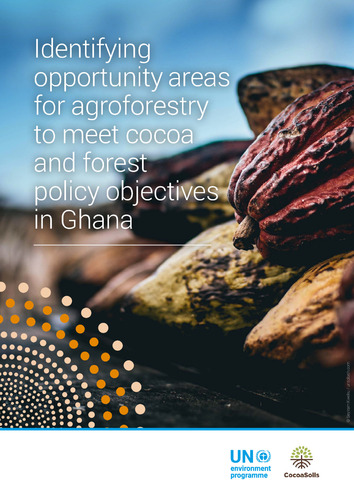Identifying opportunity areas for cocoa agroforestry in Ghana to meet policy objectives
Ghana is one of the world’s leading cocoa producers. Between 1994 and 2018, the area under cocoa production has nearly ripled. This has increased income, but it has also imposed costs. As rainforests have been converted into land for cocoa farming, habitat for species has decreased and become increasingly fragmented in one of the world’s biodiversity hotspots. Rainforest loss also has huge implications for the ability of land to capture carbon and mitigate climate change globally. Expansion of cocoa farming is expected to aggravate these issues further.
To increase income from cocoa, Ghana could expand cocoa plantations but increasing yields on the plantations that it already has would be better for both farmers and the environment. Cocoa yields in Ghana are low and the prices that the crop gets on the global market are poor. This is because most plantations in Ghana are small and run by farmers who often lack the right knowledge, resources and credit to apply management practices, like pruning, pest control and managing soil fertility, that would help them to increase the quality and size of their yields. Climate change is also expected to make lives harder and
put the cocoa supply chain at risk by making yields lower than they already are. Agroforestry farming systems are increasingly being proposed as a solution to address these problems and a potential way for the small-holder cocoa farmers of Ghana to improve their livelihoods and for the cocoa sector to maintain a sustainable cocoa supply.
Cocoa can be grown in direct sunlight or under shade provided by taller trees. Farmers in Ghana have been advised over the years that shade would harm their cocoa production, but evidence shows that well-managed shade can also benefit it. Shade trees suppress weed growth and provide habitats for predatory species that control insect pests. Growing cocoa under shade trees also helps to create a stable microclimate beneath the canopy. It can also enhance soil fertility and provide farmers with supplemental income when these other trees produce commercially valuable fruits and timber. Most importantly, well-shaded
cocoa plantations will experience lower maximum temperatures than are expected from climate change, can store up to 2.5 times more carbon than those that are unshaded and support higher levels of biodiversity that help protect valuable ecosystem services.
The types and magnitude of benefits from agroforestry systems for different beneficiaries depend highly on their design and the local context. Shade trees can harbour pests. They can also compete with cocoa for resources like water. This is particularly true in drier areas. High humidity levels under canopies created by other plant species can also foster fungal diseases. These
challenges are not to be ignored but, when agroforestry systems are well designed, they are outweighed by the overall benefits in smallholder production systems. Indeed, Ghana is now promoting cocoa agroforestry through national level policies such as the Cocoa and Forests Implementation plan, the Ghana Cocoa Forest REDD+ Programme (GCFRP) and the National Climate-Smart
Agriculture and Food Security Action Plan.
It is not realistic to establish shaded plantations throughout the southwestern regions of Ghana all at once. The process will need to be staged as there are 2.3 million hectares of plantations and 1.9 million of them currently have little to no shade. Areas where benefits from increased shading will be highest need to be identified and prioritised. This new work looked at the locations of all cocoa plantations in the country and applied cocoa and forest national policy objectives as well as spatially explicit climate change adaptation strategies to implement a transition towards more shaded cocoa farming. Using modelling approaches, the work
sought to understand the biodiversity, carbon sequestration and erosion control benefits granted by increased shading being implemented in different locations. Combined, this information generated a map that reveals the areas where the implementation of shading would be most beneficial for achieving a combination of benefits for people, nature and climate.
The work shows that establishing appropriately shaded and well-managed plantations in the proposed areas has the potential to protect at least 4,000 tonnes of sediment from erosion each year and store an additional 52 million tonnes of carbon in trees. While shifting to this sort of farming will have some implementation costs and not yield the immediate financial gains that would be
expected from more forests being converted into plantations, such a transition can yield significant long-term benefits as smallholder farmers face the challenges presented by a changing climate. When implemented appropriately, it will also enhance ecosystem services that benefit cocoa production, conserve biodiversity and support the livelihoods of farmers. Above and beyond all else, the carbon sequestration benefits granted by shaded plantations have the potential to play a pivotal part in combating climate change. For this to be fully realised, farmers need to be incentivised to adopt agroforestry practices by giving them ownership of the land that they are farming and the trees that grow there. Paying them for the ecosystem services that their land provides would further these incentives by strengthening and diversifying their income too. Beyond the specific situation faced by cocoa farmers in Ghana, this study demonstrates the potential for decision-makers to use spatial planning to understand where, and (partly) how, to implement cocoa agroforestry at scale to meet different objectives.

